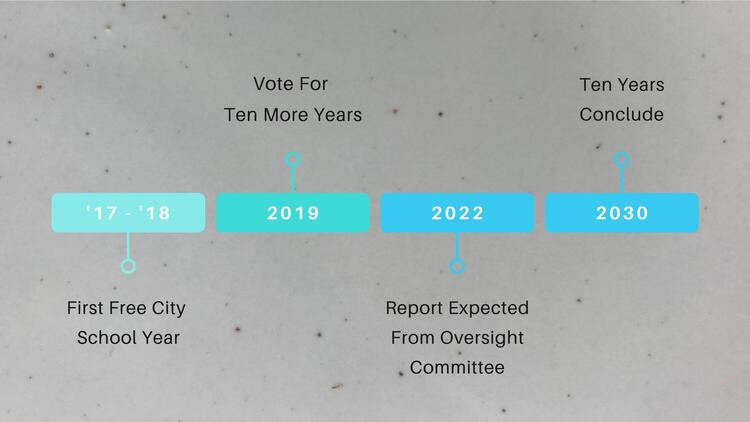Free City College is a Model for the Nation
By Robert Holzmann
robertjholzmann@gmail.com
National free community college was cut out of Biden’s final spending bill, but we can look to the City College of San Francisco’s Free City program and its strengths and weaknesses to show how it can be done.
San Francisco’s ‘Free City’ program is the first of its kind to offer free community college to all residents, with additional funds available for those who qualify. The program was designed to make higher education more accessible to a broader range of the community while boosting CCSF’s enrollment, which has steadily declined in recent years.
California has offered free tuition to qualified, low-income students for more than three decades, but the process to receive those funds can be confusing and cumbersome for students and their families. There are additional barriers that keep some students from receiving this aid, such as the need to be recent a high school graduate or class load minimums. Free City, however, offers free tuition across the board to ensure all residents have the same opportunity.
Studies conducted by the Upton Institute for Employment Research and the University of Tennessee show that the clear messaging of ‘free tuition’ can increase enrollment for some who might not otherwise attend.
During the 2017-2018 school year, the program’s first year, Free City aided over 24,000 students and total enrollment grew by 22.3% . In a survey by the City College Oversight Committee, more than 50% of Free City enrollees stated that they would not currently be in college without the program. “I would not have attended were it not for Free City,” the report quoted from an unnamed student. . “This program has literally changed my life!”
Enrollment at CCSF fell roughly 39% over the past decade. Many point to chronic financial and managerial issues and the accreditation crisis from 2012-2017, during which the school’s accreditation was under threat, as major causes. The Covid-19 pandemic further caused a precipitous decline. . The drop in enrollment has also caused the college to lose millions of dollars in state funding.

In 2019, after an initial two-year pilot period, the Board of Supervisors unanimously voted to extend Free City for another ten years with a budget of $15 to $16.4 million annually. The legislation also called for greater oversight of program operations and agreed-upon accountability metrics.
After the popularity of Free City and other free-tuition programs across the country, President Biden made nationwide free community college part of his platform. Unfortunately, the program didn’t make it into the final spending bill, but Biden assured his supporters that free community college remains a top agenda item. At a CNN town hall, he said, “I’m not going to give up on community colleges as long as I’m president.”
The Free City program has not been without its growing pains. Over its first two years, the program went close to $5 million over budget and a recent audit found a $1.5 million discrepancy in billing that the college must return to the city. According to the audit, the billing discrepancies stemmed from the college billing funds outside the scope of its agreement and not properly reporting those funds to the city. This included money for IT support, computer equipment and administrative salaries and benefits.
The college says they are taking the recommended steps, including continuing regular oversight meetings, coordinating better with the city and defining eligible administrative expenses, to avoid future disagreements. The same audit ultimately determined that “the program is sustainable for the foreseeable future” and Free City “in its current form is set up to maximize access to program funds and education”.
Free tuition programs help many students get their foot in the door but there is room for improvement for retaining and graduating those students. Only about 16% of students who attend California community colleges earn a degree, certificate or successfully transfer out within four years, with Black and Latino students being disproportionately affected.
There is “a lot of need in California and completion issues,” according to Jessica Thompson, Associate Vice President at The Institute for College Access & Success (TICAS).
In a study on improving community college completion rates, the Brookings Institute pointed to the need to address certain structural and motivational barriers that students encounter. The study describes the benefits of a more personalized education for students, the need to move away from the “cafeteria style” that many community colleges currently offer, and how students can be more successful with specific goals and an understanding of how their schoolwork is meaningful to their lives. “They need to both see the destination and the path to get there,” study author Elizabeth Mann Levesque wrote.
In order to properly measure the success of Free City, the college and the city need to decide what its objectives are. According to the 2017-2018 Free City report, the oversight committee recommended the program create specific goals and ways to measure them, so that there are clear objectives to strive for. City College’s Media Relations Director, Rosie Zepeda said that the Free City program is continuing its work on establishing those goals and measures. A new oversight committee report is due in early 2022.

Robert,
CCSF has to get its finances in order 1st. read this:
https://www.sfexaminer.com/news/auditors-find-discrepancies-in-san-francisco-city-college-billing/